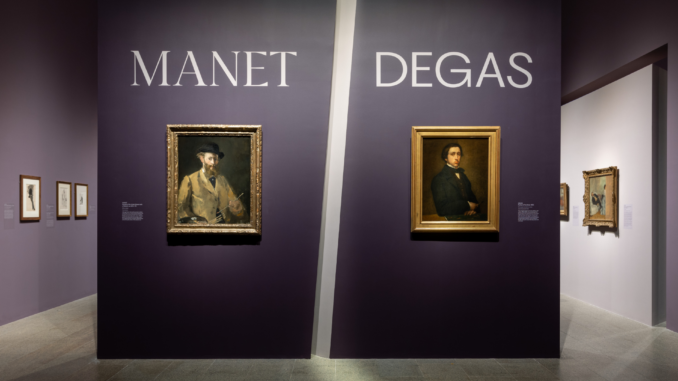
By Paulina Gajewski
The Metropolitan Museum of Art brought together 160 works from around the world by French artists Édouard Manet and Edgar Degas at an exhibit that premiered on Sept. 24. CUNY students may pay what they wish with a valid ID to enter the exhibit after waiting on the museum’s virtual waitlist.
The exhibit does not just display the various works of Manet and Degas in conjunction with one another. Instead, they are explicitly placed to demonstrate the enigmatic relationship between the two painters over the course of their artistic lives.
Entering the exhibit, the viewer first lays their eyes on a diagonal laceration between a work from each of the artists. The periodic rivalry between the two artists is represented in the juxtaposition between their works, which the curatorial team exemplified in their preliminary choices of designing splices between the purple walls.
Stephan Wolohojian and Ashley Dunn, the two curators of the exhibit, took inspiration and managed to import the majority of the exhibition from the Musee d’Orsay in Paris, where it resided from Mar. 28 to July 23 earlier this year.
Wolohojian has served as the curator in the Department of European Paintings at the Met since 2015, and spent a decade prior at the Harvard art museums. In 2021, he was named the John Pope-Hennessy Curator of the department, a role which entails working with applicants from major museums to curate exhibits.
Dunn joined the Department of Drawings and Prints in 2016, and is responsible for nineteenth-century French art, with two curated exhibits under her belt.
The Paris of the mid-nineteenth century was characterized by a booming economy and an exponentially growing consumer class. Slums were replaced by promenades and waterfronts. Department stores were built along lush parks and boulevards. The modern Paris, embodied by fashion, operas, and cafés, quickly became a subject of artistic fervor.
Ironically, the medium that aimed to capture this modern world was part of an institution that was resisting these changes. The Salon of France promoted state-sponsored exhibitions, where the academy would admit auditioned artworks that both upheld the neoclassical genre of realism, as well as pertaining to one of three topics: religion, history, or mythology.
Manet and Degas, both French painters of the upper class, attempted to challenge the notions of art as it was accepted in mid-nineteenth-century society. Manet, who had two of his works accepted into the Salon, decided to confront notions of art by submitting nude female portraiture. “Manet presents us with a female nude who has no guise of mythology,” Dunn said in a podcast on the Met’s website. “She is a contemporary woman, a model named Victorine Meurent, and she is shown as a courtesan, and she has a direct gaze out at the viewer, and her gaze places the spectator in the position of patron.”
Degas, on the other hand, was taking part in an art movement far less acceptable. Part of a group called “the New Realists” of the nineteenth century, which paved the way for impressionism, Degas understood how the changing world was going to impact art. Impressionist paintings, often associated with Claude Monet’s work, attempted to capture the industrial, fast-paced world of art.
Busy individuals often pick up their pens to scribble down notes in a flurry of words. Or make note of remarks in shorthand, attempting to grasp them before they inevitably leave their minds. Similarly, the quick, short brush strokes of the Impressionists attempted to capture the movement of this new world.
Masses of people were no longer living out long, toiling days out in the fields. They were hopping on steam trains and boats, rushing off to the cities, visiting the new race tracks used for horse racing. And, for the first time, the main subjects of portraiture were no longer nobility and aristocrats. They were instead replaced by the rising middle class, engaging in reading, shopping, and spending their time at parks and operas.
Degas, a friend of Manet’s at the time, painted a tender scene between Manet and his wife Suzanne. Degas returned to the apartment shortly after, recounting that Manet had slashed the painting that cropped almost a fourth of it. While Manet had already achieved fame, Degas still remained unknown, and would often say of Manet that “He is more vain than intelligent,” as recounted in The New York Times.
The art world was competitive, which is what art historians believe fostered this rivalry between Manet and Degas. They would often argue that one was plagiarizing the works of the other, and some might see the parallels in their works at the exhibit.
What has puzzled historians is the undeniable proof that the two artists were great friends, as revealed in a series of letters and notes written both to and about one another. After Manet’s death, Degas took it upon himself to acquire over eighty of his works into his own collection. He reunited the previously fragmented “Execution of Maximilian,” one of Manet’s most ambitious works.
Regardless of the competition between the two painters, they aided in expanding artistic genres to encompass a modern world and shattered the preconceived notions of what art was meant to be. In order to do so, they studied the works of their predecessors, utilizing museums as their classrooms. “They could see history in color,” said Wolohojian in the podcast. “The Louvre became a training ground that could in many ways even substitute for the traditional classroom experiences of the Academy.”
In a similar fashion, visitors can view this exhibit on display at the Met until Jan. 7 next year.
